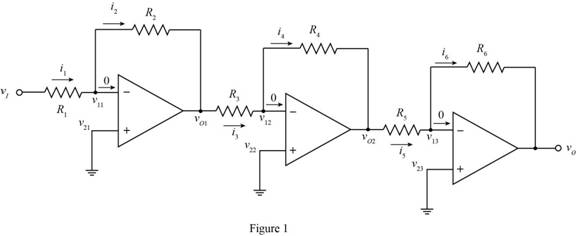
Concept explainers
Design an amplifier system with three inverting op-amps circuits in cascadesuch that the overall closed-loop voltage gain is
The design parameters for an inverting op-amp circuit.
Answer to Problem D9.18P
The value of the resistance
Explanation of Solution
Calculation:
The required diagram for the inverting op amp with feedback is shown below.
The required diagram is shown in Figure 1.

The expression for the value of the voltage
Substitute
The expression for the voltage
Substitute
The expression for the value of the voltage
Substitute
The expression for the output voltage of the first op-amp is given by,
The expression for the second voltage of the first op amp is given by,
Substitute
The expression for the voltage gain is given by,
Substitute
Apply KCL at the negative terminal of the right most op-amp.
Substitute
Substitute
Substitute
The expression for the value of the current
Substitute
The expression for the value off the voltage
Substitute
The expression for the value of the current
Substitute
The expression to determine the range of the current is given by,
Substitute
The expression for the value of the mid stage gain is given by,
Substitute
The expression for the minimum value of the resistance
Substitute
The maximum value of the resistance
The expression for the value of the resistance
Substitute
The expression for the gain of the voltage gain of right most amplifier is given by,
Substitute
The value for the current
The expression for the value of the resistance
Substitute
The expression for the maximum value of the resistance
Substitute
Conclusion:
Therefore, the value of the resistance
Want to see more full solutions like this?
Chapter 9 Solutions
Microelectronics: Circuit Analysis and Design
- Based on the op amp circuit in Figure, answer the following questions,assuming an ideal op-amp. Given:V1 = 1 VI2 = 2 mAV3 = 0.5 VRa = 2 kΩRb = 1 kΩRc = 5 kΩRd = 10 kΩVx = 4VIb = 3.5mANow I need to determine Vo and the current and power through Rd.Please help, Thank youarrow_forwardThe op amp in the circuit shown is ideal. 1. Calculate vo if va=1 V and vb=0 V. 2. Repeat (a) for va=1 V and vb=2 V. 3. If va=1.5 V, specify the range of vb that avoids amplifier saturation.arrow_forwardFigure Q. 3(b) shows an op amp circuit for linear amplifier application. (i) Determine the value of current I3.(ii) Find the value of R if the output current, Io is given as 2 mA.(iii) Explain what will happen to output voltages, V01 and V02 if the supplyvoltages, +VCC and -VCC are connected to +10V and -10V.arrow_forward
- The op amp in the circuit shown shown is ideal. The adjustable resistor RΔ has a maximum value of 100 kΩ, and a is restricted to the range of 0.2 =a=1. Calculate the range of vo if vg=40 mV.arrow_forwardFor the circuit configuration below with R1 =6Ω, R2 =5Ω,R3 =4Ω, R4 =7Ω, R5 =15Ω, R6 =16Ω, vg=27V, with ideal op-amps, calculate v0.arrow_forward1. For the circuit shown, show that if ΔR<<R, the output voltage of the op amp is approximately vo≈Rf(R+Rf)R2(R+2Rf)(−ΔR)vin. 2. Find vo if Rf=470 kΩ, R=10 kΩ, ΔR=95 Ω, and vin=15 V. 3. Find the actual value of vo in (b).arrow_forward
- A circuit is constructed by amplifier components as follow, R1= 4 Ω; R2= 2Ω; R3= 5 Ω; R4= 1 Ω; R5= 2 Ω,I= 0.3 A and Vs= 5 Volt. Find V1, V2,and V3.arrow_forwardDesign an amplifier which will produce the average of 8V, 2V and 12 V in an inverted phase. Only one amplifier is allowed to be used. i) Select the resistances accordingly and draw the circuit designing with the mentioned specifications. ii) Explain and show all calculations.arrow_forwardA summing amp has the following values: R1 = 1.1kΩ R2 = 1.1 kΩ, R3 = 2kΩ, Rf = 2.4kΩ, V1 = 1.9V V2 = 1.5 V, V3 = -3.1 V. The output of this circuit isarrow_forward
- Hi please calculate for the CMRR (measured) with resistor values: R1 = 995 Ohms R2 = 100.8 kOhms R3 = 1003 Ohms R4 = 99.7 kOhms Assume that the op amp itself has infinite CMRR. I will upvote thanks!arrow_forwardThe op amp in the adder-subtracter circuit shown shown is ideal. Find vo when va=1 V, vb=2 V, vc=3 V, and vd=4 V.arrow_forward2. Calculate the output voltage of an op-amp summing amplifier for the followingsets, consider Rf=1Mna. V1=+1v, V2=+2v, V3=+3v, Ri=R2, R3=500Ω b. V1=+1v, V2=+2v, V3=+3v, Ri-500kΩ, R2=1MΩ, R3=1MΩarrow_forward
 Delmar's Standard Textbook Of ElectricityElectrical EngineeringISBN:9781337900348Author:Stephen L. HermanPublisher:Cengage Learning
Delmar's Standard Textbook Of ElectricityElectrical EngineeringISBN:9781337900348Author:Stephen L. HermanPublisher:Cengage Learning
